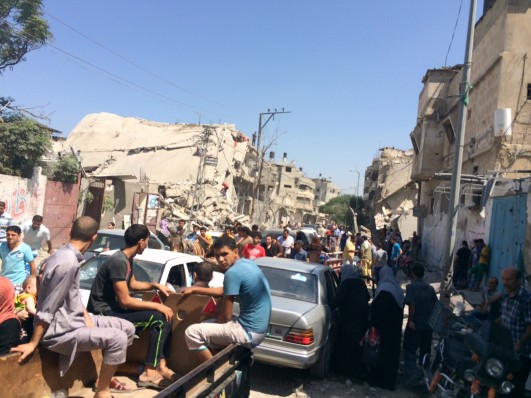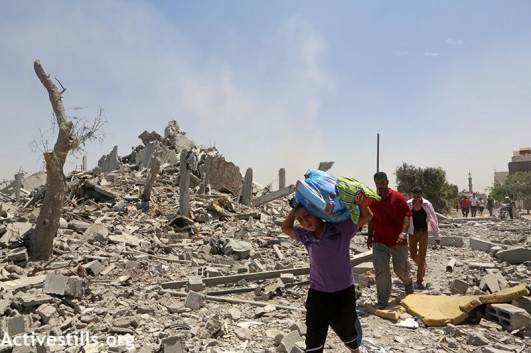A 72-hour ceasefire between Hamas and Israel was called off Friday morning after a mere two hours. Samer Badawi visited the Gazan towns of Shejaiya and Khuza’a, where people rushed to retrieve their belongings before the fighting resumed.
GAZA CITY – After a night of relentless shelling from tanks and naval warships, a ceasefire meant to take hold in Gaza at 8 a.m. this morning quickly devolved into fierce fighting on two fronts along the Strip’s eastern and southern borders. As of this writing, Israeli shelling in Rafah had killed 40 Palestinians, and heavy bombardment was visible east of Gaza City, near the already battered towns of Shejaiya and Khuza’a.
Just after the ceasefire took effect, residents of both eastern towns scrambled to retrieve what they could of their belongings as news of the renewed fighting filtered through the chaotic scene.

Children hurried on foot through lines of cars, trucks, and donkey carts, carrying backpacks filled with their schoolbooks. Adults carried mattresses, gas canisters and infants too young to walk. Teenagers hauled away remnants of the earlier Israeli assault – metal ammunition cases, bullet casings, spent tank shells and mortars.
Despite the chaos, the scene was eerily quiet. “See that man there,” said one resident taking a break on the side of the road. “He lost nine family members in the fighting.” The man walked past us with a heavy gait, solemn but stoic. Another resident from the Munasra family stood inside her gutted home, describing how 40 members of her extended family fled on foot, returning to find blackened walls or others that, simply, were no longer standing. “We had a couch here,” she said, pointing to a floor that was only shards of glass and concrete. “I guess it disappeared in the flames.”
The families seemed unfazed when the sound of automatic rifles rattled the air some 90 minutes after they had returned. Later, we learned that, around the same time, a Palestinian man had been shot dead nearby by Israeli snipers.
That, say Gaza’s residents, was how the ceasefire broke. But the Israeli military claimed the shots were in response to a Hamas operation in which fighters, using a tunnel under the Rafah border, kidnapped an Israeli officer. Hamas issued a statement saying the kidnapping took place before the ceasefire.

As the two sides traded blame, news of the kidnapping spread quickly, and Gaza became a mix of frenetic activity and dread. Residents scrambled to buy bread, charge phones and hunker down before what the Israeli military vowed would be a massive response.
It came almost immediately. As artillery units pounded Rafah, we heard from one resident that Israeli forces had warned residents to leave the area. Meanwhile, UNRWA reported that the number of displaced Gazans had already reached more than a quarter-million. With more than 120,000 residents in Rafah, their numbers would push the total number of displaced above 20 percent of Gaza’s population. With 44 percent of Gaza’s territory now consumed by Israel’s expanded “buffer zone,” it’s unclear where Rafah’s displaced would go or how the UN agency charged with sheltering them would cope.
But they are on the move. Said one Rafah resident reached by phone, “We’ll go anywhere just to stay away from the tanks. They’re much scarier than the F-16s – because they’re completely random.”
“Anyone can die at any moment.”
Related:
40 Palestinians killed; IDF soldier captured by Hamas
Photos: Deadly week in Gaza
Blaming Palestinians for their own deaths


